Rage syndrome, often misunderstood, is a serious behavioral concern that can affect any breed of dog. A dog with rage syndrome will display unpredictable and intense aggression. This guide will help you understand this devasting condition and how to manage it.
What is Rage Syndrome?
Rage Syndrome, also known as Sudden Onset Aggression or SOA, is a rare but serious behavioral condition in dogs. It’s characterized by extreme, sudden aggression with little or no warning. The dog may appear perfectly normal one moment, then suddenly launch into a violent rage the next.
This condition is often misunderstood and misdiagnosed, as it can be confused with other forms of aggression. It’s crucial to understand that rage syndrome is not a reflection of poor training or a ‘bad’ dog. It’s a neurological disorder, much like epilepsy.
The Symptoms of Rage Syndrome
The symptoms of rage syndrome can vary greatly, but the following are the most common:
- Sudden, extreme aggression with no apparent trigger
- A glazed or ‘wild’ look in the eyes during an episode
- Attacking anyone or anything in the vicinity during an episode
- Returning to normal behavior immediately after an episode
In extreme cases, dogs with rage syndrome may even injure themselves during an episode.
Causes and Risk Factors
The exact cause of rage syndrome is still unknown, but it’s believed to be a neurological disorder. Certain breeds, such as Cocker Spaniels and Springer Spaniels, are more prone to this condition, suggesting a genetic component.
| Breed | Risk Level |
|---|---|
| Cocker Spaniel | High |
| Springer Spaniel | High |
| Other Breeds | Low/Moderate |
Aside from breed, there are no known risk factors for developing rage syndrome.
Managing Rage Syndrome
Managing rage syndrome can be challenging, but it’s not impossible. Here are some tips:
- Seek professional help: A professional canine behaviorist with experience in dealing with rage syndrome can help you manage your dog’s behavior.
- Medication: In some cases, medication can help control the episodes.
- Avoid triggers: If you can identify any triggers for your dog’s episodes, avoid them if possible.
- Provide a safe space: Ensure your dog has a safe, quiet place to retreat to if they’re feeling stressed or anxious.
Remember, your dog is not ‘bad’. They are suffering from a medical condition and need your understanding and compassion.
FAQs
Q: Can rage syndrome be cured?
A: While there is no cure for rage syndrome, management strategies can help reduce the frequency and intensity of episodes.
Q: My dog has been showing signs of aggression. Do they have rage syndrome?
A: Not necessarily. Many behavioral issues can cause aggression in dogs. It’s best to consult with a professional to get a proper diagnosis.
Q: Can any breed of dog develop rage syndrome?
A: While any breed can theoretically develop rage syndrome, it is more commonly seen in Cocker Spaniels and Springer Spaniels.
Q: Is there a test for rage syndrome?
A: There is no definitive test for rage syndrome. Diagnosis is usually made based on observed behavior and ruling out other possible causes of aggression.



